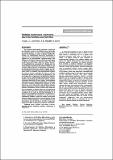Por favor, use este identificador para citar o enlazar a este item:
http://hdl.handle.net/10261/2151COMPARTIR / EXPORTAR:
 SHARE
BASE SHARE
BASE
|
|
| Visualizar otros formatos: MARC | Dublin Core | RDF | ORE | MODS | METS | DIDL | DATACITE | |

| Campo DC | Valor | Lengua/Idioma |
|---|---|---|
| dc.contributor.author | Lasa, Íñigo | - |
| dc.contributor.author | Pozo, J.L. del | - |
| dc.contributor.author | Penadés, José R. | - |
| dc.contributor.author | Leiva, José | - |
| dc.date.accessioned | 2007-11-15T10:02:13Z | - |
| dc.date.available | 2007-11-15T10:02:13Z | - |
| dc.date.issued | 2005-08 | - |
| dc.identifier.citation | Anales del Sistema Sanitario de Navarra 28(2): 163-175 (2005) | en_US |
| dc.identifier.issn | 1137-6627 | - |
| dc.identifier.uri | http://hdl.handle.net/10261/2151 | - |
| dc.description.abstract | [ES] En los países desarrollados tendemos a pensar que las principales causas de mortalidad son las enfermedades cardiovasculares y el cáncer en sus múltiples modalidades. Sin embargo, los datos en Europa resultan elocuentes; las enfermedades infecciosas representan la segunda causa de mortalidad (14,9 millones de muertes), después de las enfermedades cardiovasculares (16,9 millones de muertes) y causan el doble de muertes que el cáncer (7,1 millones de muertes) (datos del World Health Organization, WHO, 2002). Los agentes infecciosos responsables de mortalidad en el hombre han ido evolucionando a medida que las medidas higiénicas y las técnicas médicas han ido evolucionando. Actualmente, las enfermedades infecciosas agudas causadas por bacterias patógenas especializadas como la difteria, tétanos, peste, cólera o la tosferina, que representaban la principal causa de muerte a principios del siglo XX, han sido controladas gracias a la acción de los antibióticos y de las vacunas. En su lugar, más de la mitad de las infecciones que afectan a pacientes ligeramente inmunocomprometidos son producidas por bacterias ubicuas, capaces de producir infecciones de tipo crónico, que responden pobremente a los tratamientos antibióticos y no pueden prevenirse mediante inmunización. Ejemplos de estas infecciones son la otitis media, endocarditis de válvulas nativas, infecciones urinarias crónicas, infecciones de próstata, osteomielitis y todas las infecciones relacionadas con implantes. El análisis directo de los implantes y tejidos de estas infecciones muestra claramente que en la mayoría de los casos la bacteria responsable de la infección crece adherida sobre el tejido o el implante formando comunidades de bacterias a las que se les ha denominado “biofilms”. Dentro del biofilm, las bacterias están protegidas de la acción de los anticuerpos, del ataque de las células fagocíticas y de los tratamientos antimicrobianos. En este artículo se describe el papel que juegan los biofilms en infecciones humanas persistentes. | en_US |
| dc.description.abstract | [EN] In developed countries we tend to think of heart disease and the numerous forms of cancer as the main causes of mortality, but on a global scale infectious diseases come close, or may even be ahead: 14.9 million deaths in 2002 compared to cardiovascular diseases (16.9 million deaths) and cancer (7.1 million deaths) (WHO report 2004). The infectious agents responsible for human mortality have evolved as medical techniques and hygienic measures have changed. Modern-day acute infectious diseases caused by specialized bacterial pathogens such as diphtheria, tetanus, cholera, plague, which represented the main causes of death at the beginning of XX century, have been effectively controlled with antibiotics and vaccines. In their place, more than half of the infectious diseases that affect mildly immunocompromised patients involve bacterial species that are commensal with the human body; these can produce chronic infections, are resistant to antimicrobial agents and there is no effective vaccine against them. Examples of these infections are the otitis media, native valve endocarditis, chronic urinary infections, bacterial prostatitis, osteomyelitis and all the infections related to medical devices. Direct analysis of the surface of medical devices or of tissues that have been foci of chronic infections shows the presence of large numbers of bacteria surrounded by an exopolysaccharide matrix, which has been named the "biofilm". Inside the biofilm, bacteria grow protected from the action of the antibodies, phagocytic cells and antimicrobial treatments. In this article, we describe the role of bacterial biofilms in human persistent infections. | en |
| dc.description.sponsorship | Financiado con los proyectos BIO2002-04542-C02 de la Comisión Interministerial de Ciencia y Tecnología, “Beca Ortiz de Landazuri” del Departamento de Salud del Gobierno de Navarra y proyecto FIS PI031102 del Ministerio de Sanidad. | en_US |
| dc.language.iso | spa | en_US |
| dc.publisher | Diputación Foral de Navarra | en_US |
| dc.rights | openAccess | en_US |
| dc.subject | Biofilms | en_US |
| dc.subject | Infecciones crónicas | en_US |
| dc.subject | Exopolisacáridos | en_US |
| dc.subject | Implantes médicos | en_US |
| dc.subject | Resistencia a antibióticos | en_US |
| dc.title | Biofilms bacterianos e infección | en_US |
| dc.title.alternative | Bacterial biofilms and infection | en_US |
| dc.type | artículo | en_US |
| dc.description.peerreviewed | Peer reviewed | en_US |
| dc.type.coar | http://purl.org/coar/resource_type/c_6501 | es_ES |
| item.openairetype | artículo | - |
| item.cerifentitytype | Publications | - |
| item.languageiso639-1 | es | - |
| item.grantfulltext | open | - |
| item.openairecristype | http://purl.org/coar/resource_type/c_18cf | - |
| item.fulltext | With Fulltext | - |
| Aparece en las colecciones: | (IDAB) Artículos | |
Ficheros en este ítem:
| Fichero | Descripción | Tamaño | Formato | |
|---|---|---|---|---|
| biofilms.pdf | 160,79 kB | Adobe PDF |  Visualizar/Abrir |
CORE Recommender
Page view(s)
790
checked on 07-may-2024
Download(s)
928
checked on 07-may-2024
Google ScholarTM
Check
NOTA: Los ítems de Digital.CSIC están protegidos por copyright, con todos los derechos reservados, a menos que se indique lo contrario.
